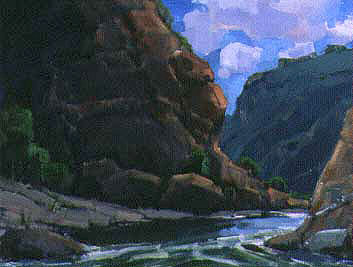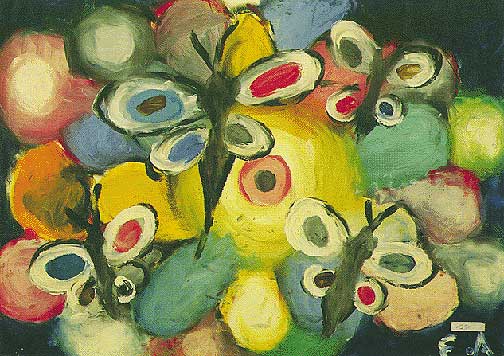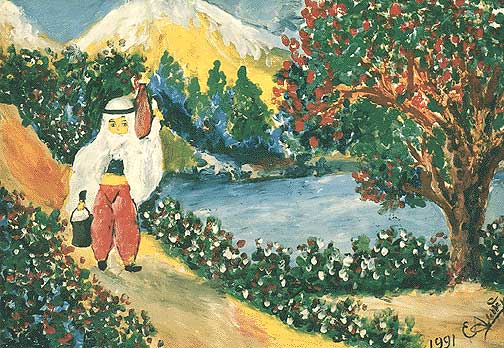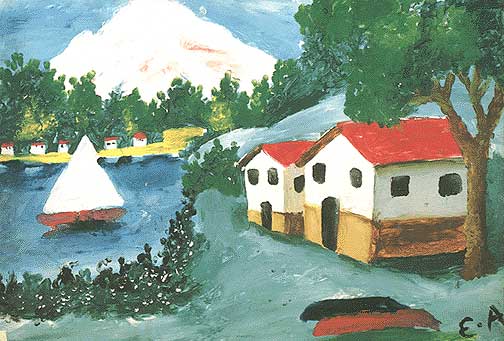Dear Artist,
Recently there has been a bit of excitement around the painter Esref Armagan. The 51-year-old native of Istanbul, Turkey, has been blind from birth. Researchers at Boston University and the University of Toronto have been analyzing his work, trying to dig into and understand his thought processes. They bombard him with questions and subject him to brain scans while he paints. His work, which could be characterized as naïve or primitive, nevertheless shows some use of perspective and other sight skills. So you get an idea of what I’m talking about, see below for samples of his work.
For the blind, being able to draw objects such as cups, fish or hammers is one thing. For these tests Armagan used the “Sewell raised-line drawing kit.” This device leaves a Braille-like line that can be felt with the fingers.
Being able to visualize and paint distant scenery in colour is something else. It’s safe to say that a tactile understanding of objects such as cubes, cones, spheres, etc., go a long way toward building a “hand’s eye” picture. “A house is like a box,” etc. Just as a sighted person looks out and sees, the blind reach out and feel, and this produces a similar understanding of the forms in our world. But Armagan’s use of colour and cast shadow presents further areas of interest. For a while he thought that shadows should be the same colour as the objects that cast them, but someone corrected him on that. While he claims no formal art teacher, his knowledge of light sources and colour choices come from the more or less casual remarks of those who look over his shoulder.
What I find so interesting about these studies and their results is not the quality of the work, but what appears to be the similarity to the processes, pitfalls and desirable effects experienced by sighted artists. The verbal nature of things helps to inform the “mind’s eye” and interferes with the actual image on the “eye’s-eye.” In Armagan there is no eye’s-eye — not even the perception of light. In him we have the extreme end of theoretical imaging. Wonderfully though, his world is just as real as any other painted world, and therein lies both its faults and its charms. One wonders what would happen should he turn his mind to thoughts of abstraction.
Best regards,
Robert
PS: “Mr. Armagan is an important figure in the history of picture-making, and in the history of knowledge. He has demonstrated for the first time that a blind person can develop on his own pictorial skills the equal of most depiction by the sighted. This has not happened before.” (John M. Kennedy, University of Toronto) “I shut my eyes in order to see.” (Paul Gauguin)
Esoterica: Armagan first draws his composition using a Braille stylus. Working with his fingers in oil or acrylic he fills in his colours. He says he feels it — as if he was “in it.” In painting the sea, for example, he says he should wear a life preserver in order to prevent drowning. According to the results of the brain scan, areas of his visual cortex light up as if he was seeing. This also suggests that the seeing of both sighted and unsighted persons is somewhat a matter of belief.
Esref Armagan Paintings
Painting not made by artist
by Alev Oguz, Istanbul, Turkey
To work on a picture, Esref Armagan needs absolute quiet. He needs to feel that he is “inside” his painting. (ref: Lively Colors of a Dark World by Joan Eroncel) This is how Eroncel describes his painting method. Once again we are faced with the power of unseen. Regardless of the level of abstraction, every inspired artist puts her feelings and moods on the canvas. At that very moment, it is not a painting made by the artist, but the artist himself.
Believing is seeing
by Dyan Law, Pipersville, PA, USA
The suggestion that seeing is perhaps, “somewhat a matter of belief” is certainly the “painter’s key” to me. I can’t imagine any artist, with or without sight, pulling off an honest work of art without a belief in their unique perception of that image, representational or abstract! By learning about the world around us through touch, through stories written (in Braille for some), by feeling the warmth of sunlight, the coolness of snow, the softness of a baby’s skin, the smell of grass, the sound of thunder (or of silence), and the feeling of love, a person without sight can truly “believe” in the image(s) which lies “within” his/her own world. We are all touched by life, those with eyes that “see” and those that do not. Perhaps the spirit we each possess allows us to believe and trust in the senses that we’re born with. We may want to revise the old saying, “Seeing is believing” to “Believing is seeing”!
Recent loss no problem
by Gail Siptak, Houston, TX, USA
I am blind in one eye. I’ve been painting since the ’60s and felt “in my stride” for the last 20-25 years. I see things, people, as compositions and ideas. I see through my paintings. If I had lost an eye (and therefore depth perception) when I was younger, it might have made work more difficult. As it happened a year ago, it has presented no problem. My mind is the painter.
Colourblind challenge
by Michael Chesley Johnson, Sacramento, CA, USA
One out of 12 men is colorblind. I don’t know the statistics for women. I am a painter and I have the usual red-green colorblindness. Fortunately, there are degrees of colorblindness, and my condition is mild. A student I tutor is so bad that we have to organize his pastel palette for him. “Is this brown?” he asks. “No,” I say, “that’s green,” or “gray” or some other color. (Blind leading the blind!) I have also read that people who are colorblind like bright, vivid colors — and perhaps this is why my paintings are bright and vivid.
Emerged from a locked brain
by Catine E. Perkins
Genetic memory is splashed all over my canvases. I opened my steel enclosure (in my brain) about my heritage. I grew up somewhat secluded with older parents… and hardly any contact with the Russian Culture, and then, from an enchanted forest into a Protestant Culture when I went to live with a much older brother at Fort Sam Houston, Texas. This further locked my brain tighter. But then, later in life, thanks to my husband and children, I received support and my fear about anything Russian vanished. Also, as I relearned the language, my English changed to Americanese and I won the freedom of expression.
Lisa Fittipaldi
by Mikaelah Morocco
Lisa Fittipaldi began painting in 1995, two years after she lost her vision. Painting was one of several avenues that Lisa explored as a way of finding her place in the world after losing her sight. She quickly understood that painting her storehouse of memories was both a source of nourishment and a way to keep her world alive in her mind. As she began to paint, she also realized that the principles of art gave her a system for comprehending and navigating the three-dimensional world she could no longer see. Whatever she learned in her painting studio, working on a two-dimensional canvas, could be applied to her understanding of the dark world she now lived in. After she understood spatial relationships and the principles of art, she could make her own way in the world as both an artist, and a human being.
(RG note) Lisa Fittipaldi is the author of A Brush with Darkness.
3-D eye exercises
by Ginia Davis, Barboursville, VA, USA
I recently picked up a book called Magic Eye 3D Hidden Treasures a collection of 3-D illustrations by Magic Eye Inc. Spending time with the book, I achieved the visual goals with several images, and then decided to spend some time painting. I had one of the best painting sessions! I realized it was the book’s visual exercises that did something for me. I read in the beginning of the book that these exercises are good for “whole mind,” “brain synchronization,” etc. Well, it made a believer out of me! I think it helps the right and left sides of the brain to focus at the same time. These visual exercises, when achieved and practiced, open doors to seeing one’s work/ideas and accomplishing one’s visions for that work.
(RG note) Magic Eye can be found at MagicEye.com
Traces what she sees
by Mary Madsen, Las Vegas, NV, USA
My daughter has always had an extraordinary gift with visual art. Even in kindergarten I could tell which drawing was hers because it was just somehow different. It wasn’t the drawing of a mature artist or a savant, just… well, I don’t know, maybe a little bit odd? She’s now 27, and we’ve been talking a lot about art lately. I was stunned to hear her say that she never drew anything in her life, she just traced what she saw on the paper or canvas. She claims she didn’t draw a perfect circle in her art class as was reported, she simply traced the circle she saw in front of her. After she told me that, I realized that I’ve never seen her use reference material of any kind, not even a photograph. She claims she stares at the canvas until she sees the painting, then goes over it with her brushes and pigment.
Braille drawing instrument
by June Szueber
At the present time we have a young girl (7th grader) in our art class who is severely visually handicapped but she works so hard and I think will make progress. I have read of the raised line drawings but do not know where to find them. She might benefit from these.
(RG note) The Society for the Blind offers writing and drawing aids such as the Sewell Raised Line Drawing Kit
Why not sculpture or poetry?
by John Ford
There’s a parallel between Mr. Armagan and Beethoven. To lose that one faculty necessary to create one’s art is the nightmare of all artists. But the key to what these men have done is in the quote you cited of Paul Gauguin: “I shut my eyes in order to see.”
Aside from the theories of why Mr. Armagan has this urge to express himself in a medium that reflects a world he is only vaguely conscious of, there is no doubt to the genius of what he is doing. It would have been more rational for him to develop a skill in an art that he could become more proficient with, one that requires a keen perception already available to him, and that would have been sculpture. If anything, he has taken the theory of sight (something he knows exists but can not experience) and put that theory to practice in its most positive light. And like Beethoven who couldn’t hear his last three symphonies, Mr. Armagan has never seen his own work much less the works of other artists. Which only poses the one question – is this the way a blind person really sees? We can’t know because even the artist cannot answer that question.
But the question posed was… how would this artist do an abstraction? Again it would be more true to his abilities if done in sculpture or… the closest concept to the abstract: poetry. If a blind person wanted to create an image of imagination, freeze a moment in time like the Impressionists, or share a part of her spirit effectively with another, that can be done to its greatest potential in poetry.
Questions about Esref Armagan
by Tatjana Mirkov-Popovicki
How certain is it that Esref Armagan has really been blind since birth?
Did he have any access to any reliefs or other types of pictures “visible” by touch?
How original are his pictures to the ones he has “seen” with his fingertips?
I am not surprised that his visual cortex is active since one of its roles is to project pictures stored in the brain (see Blank Slae by Steven Pinker). The question is how those pictures got into his brain in the first place. Is it possible that they were composed from the information gathered by the tactile sense and by the descriptions received from other people? Or did they get there by copying existing pictures which are visible by the tactile sense? Or did they get there in the very early childhood in the case that the artist wasn’t really born blind.
The capacity of the brain to deal with this situation is admirable; it is obviously a huge asset to any animal who shares that ability with humans. Though when you think that way, it’s not much of a surprise, is it? Many animals living underground in the darkness have clear concepts of their surroundings.
In any case, it is important to recognize that a large amount of the things that we think we are seeing with our eyes, are not sothey are just being projected by our brain from the collection of the information that we have stored in our brain. This is important to remember when we are driving and our mind is not fully alert, as well as when painting a difficult subject and our brain is unconsciously looking for shortcuts and easy ways out.
(RG note) A source for the recent studies on Esref Armagan is here.
Is “self-taught” any good?
by Hanneke Spruijt-Teunissen, The Netherlands
Do you think a self-taught artist can ever develop that je ne sais quoi — the freedom and ease that a “schooled” artist has? By self-taught I mean someone who reads books on art and painting, someone who goes to evening courses at the local art institute or school and who goes to art galleries, who is curious and informed, but who does not have a background of four to six years rigorous schooling under the watchful eye of a professor or instructor. And I’m referring to artists who strive for a certain amount of realism in painting.
So often it’s easy to detect the “self-taughts.” There may be a certain flatness in shadows, something askew in perspective, a tightness in the handling of the brush. It’s discouraging sometimes, because I’m one of those self-taught artists, and I have a sense of there being a limit to my development because of my lack of formal schooling in art.
(RG note) Thanks, Hanneke. If you look around you’ll find that a great many popular and successful artists consider themselves self-taught. They may even have had a formal art education — but later found that it was what they learned after they finished that really counted. Books, these days, are better than ever. Artists, particularly painters, who have the “worker’s edge” are often graduates of sign shops, ad agencies or other studios of graphic or commercial art. Lively shadows, proper perspective and brilliant brushwork are mastered in the school of sweat.
Rendezvous on the dock
by Pua Maunu, Juneau, Alaska, USA
I just want to let you know that a bunch of plein aire painters and subscribers here in Juneau, Alaska (aptly named Plein Rein) are excited about your travels this coming September on the cruise ship. When you dock in Juneau, Alaska, we would like to meet you and other members of the group traveling with you. Is there perhaps a possibility of going out together and creating? We will be talking about it on a weekend painting trip in a couple of weeks.
(RG note) Thanks, Pua. We’ll be happy to meet up with you and the Plein Reiners on the dock. We’ll bring our paints and our rein gear.
Biennale in Romania
by Anonymous
I was invited (by someone who had seen my art on the internet) to participate in an exhibition at the Biennale of Contemporary Art in Arad, Romania. I am worried because I have to pay a 250 Euro fee and I am responsible for all shipping fees to Romania. I also don’t know the lady who invited me, though I have checked out her art on the web. This show has a website here. What do you think of this invitation? To be honest I have some trepidation.
(RG note) They must be getting addresses from our links pages as several artists have asked this. Like others, this is an art fair that charges a fat fee. Acceptance is based largely on your willingness to pay. The only possible reason to consider this venue is that you want to tell people that you have been hung in Romania.
Dark and secret places
by Nicci Glick
I was widowed this year and know the feeling of proceeding blind. I have taken 10 months off to find my life. I was so committed to being a partner in life and business that I gave up more than I realized. I have been given time and space to explore the unseen world that lay dormant deep inside. After reading your wonderful letter, I realize I am searching dark and secret places that needed to be found once again, in order to reclaim the life I am meant to live now. I am using eyes that see deeply and accurately into the places that your letter gives me, another measure of peace as I put this into perspective. How exciting to reclaim the artist, writer and free spirit that I took for granted. Thank you for shining a light on my path. I am also grateful to Luann Udell for sending your link to me several months ago. She is a magnificent person, an incredible friend and gifted artist.
(RG note) Thanks, Nicci. By far the majority of our connections to and through this letter and responses are made through friendship. Let us be thankful for friendship.

oil painting |
You may be interested to know that artists from every state in the USA, every province in Canada, and at least 115 countries worldwide have visited these pages since January 1, 2005.
That includes Aleta Pippin who wrote, “It always feel good when I read how others feel about your comments and their insights triggered by those comments. Sometimes their comments cause me to feel so connected with them as well as with my own life, that I feel those joyful tears that spring forth from the solar plexus when you feel truly connected to infinite love.”
And also Odette Nicholson who wrote, “On the topic of images, light perception and seeing, you should take a look at Vision and Art: The Biology of Seeing by Margaret Livingstone.
And also Sara Genn of New York who wrote, “It would be my assumption that a blind person would create work based on observations of their intimate world. Then again perhaps a blind person wants to “represent” the greater world even more badly than the average painter.”















